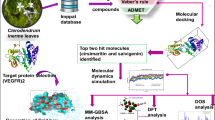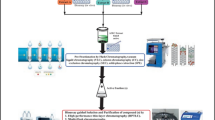Abstract
Background
Daphne pontica is an endemic plant grown wild in the North part of Iran, with anticancer activities.
Objectives
This study aims to analyze the phytochemistry and screen the cytotoxic activity of new bioactive compounds against a panel of cancer cells, in addition to proapototic properties against prostate cancer cells.
Method
Purification procedure was done using repeated column chromatographies by MPLC and HPLC systems. The structures were elucidated by the NMR and exact mass spectroscopy, stereochemistry by NOESY, and absolute configuration by electronic circular dichroism (ECD) spectra. Cytotoxicity was done against DU 145, LNCaP, HeLa, MCF-7, and MDA-MB 231 cells by standard MTT assay. An annexin V/PI assay was performed to measure the type of death following treatment with these compounds for 48 h, followed by the caspase-3 activity test.
Results
In this study, one new dilignan named lignopontin A (9), in addition to 13 known compounds including two phenolic acids (3, 5), one flavanone (6), one bis flavonoid (1), one cumarin glycoside (2), one mono (4) and two dicumarins (10, 11), two lignans (7, 8), and three daphnane diterpenoids (12-14) were isolated for the first time from D. pontica stems. Complete spectral data of compound 12, named as 6,7α-epoxy-5β-hydroxy-9,13,14-ortho-(4,2E)-pentadeca-2,4-diene-1-yl)-resiniferonol, and compound 14, named as 6,7α-epoxy-5β-hydroxy-9,3,14-ortho-(2,4E)-pentadeca-2,4-di-1-yl)-resiniferonol-12β-yl-acetate are reported for the first time. In the MTT assay of newly described compounds against a panel of cancer cells, compounds 9, 12, and 14 possessed moderate to potent cytotoxicity against prostate, breast, and cervical cancer cells in a dose-dependent manner. Flow cytometry analysis against prostate cancer cells indicated that the cytotoxicity of compounds 12 and 14 was due to their ability to induce apoptosis. In the case of compound 9, in Du 145 cells, cell death was mainly through apoptosis. In contrast, LNCaP cells showed both apoptosis and necrotic cell death, predominated by necrosis at the higher concentrations. Caspase-3 activity confirmed apoptosis observed in these compounds through the caspase pathway in prostate cancer cells.
Conclusion
D. pontica is a new source of dimeric phenolic compounds, including bisflavonoids, phenylpropanoid-cumarin adduct, and dilignans, as well as daphnane diterpenoids with resiniferonol core with long-chain orthoester moieties. In cytotoxicity screening, compounds 9, 12, and 14 inhibited the growth of DU-145 and LNCaP cells in a dose-dependent manner with IC50 varied from 0.9 – 27.3 and 25.2 - 87.4 μM, respectively. Among them, 9 exhibited selective growth inhibition against DU 145 treated cells. LNCaP cells demonstrated the highest sensitivity to treatment with compound 12.
Graphical abstract








Similar content being viewed by others
Data availability
The datasets used and/or analysed during the current study are available from the corresponding author on reasonable request.
References
Sovrlić MM, Manojlović NT. Plants from the genus Daphne: A review of its traditional uses, phytochemistry, biological and pharmacological activity. Serb J Exp Clin Res. 2017;18(1):69–79.
Xu WC, Shen JG, Jiang JQ. Phytochemical and biological studies of the plants from the genus Daphne. Chem Biodivers. 2011;8(7):1215–33.
Umezawa T. Diversity in lignan biosynthesis. Phytochem Rev. 2003;2(3):371–90.
Jin Y-X, Shi L-L, Zhang D-P, Wei H-Y, Si Y, Ma G-X, Zhang J. A review on daphnane-type diterpenoids and their bioactive studies. Molecules. 2019;24(9):1842.
Hong J-Y, Nam J-W, Seo E-K, Lee SK. Daphnane diterpene esters with anti-proliferative activities against human lung cancer cells from Daphne genkwa. Chem Pharm Bull. 2010;58(2):234–7.
Zhan Z-J, Fan C-Q, Ding J, Yue J-M. Novel diterpenoids with potent inhibitory activity against endothelium cell HMEC and cytotoxic activities from a well-known TCM plant Daphne genkwa. Biorg Med Chem. 2005;13(3):645–55.
Zhang S, Li X, Zhang F, Yang P, Gao X, Song Q. Preparation of yuanhuacine and relative daphne diterpene esters from Daphne genkwa and structure–activity relationship of potent inhibitory activity against DNA topoisomerase I. Biorg Med Chem. 2006;14(11):3888–95.
Nie YW, Li Y, Luo L, Zhang CY, Fan W, Gu WY, Shi KR, Zhai XX, Zhu JY. Phytochemistry and Pharmacological Activities of the Diterpenoids from the Genus Daphne. Molecules. 2021;26(21):6598.
Tosun A, Özkal N. Studies on the anatomical structure of the leaf and stem of Daphne pontica L.(Thymelaeaceae). Fabad. J Pharm Sci. 2002;27(4):205–10.
Sanda MA, Zengin G, Aktumsek A, Cakmak YS. Evaluation of antioxidant potential of two Daphne species (D. gnidioides and D. pontica) from Turkey. Emir J Food Agric. 2015:4878–494.
Kumar S, Bajwa BS, Kuldeep S, Kalia AN. Anti-inflammatory activity of herbal plants: a review. Int J Adv Pharm Biol Chem. 2013;2(2):272–81.
Kupeli E, Tosun A, Yesilada E. Assessment of anti-inflammatory and antinociceptive activities of Daphne pontica L.(Thymelaeaceae). J Ethnopharmacol. 2007;113(2):332–7.
Gürbüz İ, Demirci B, Franz G, BAŞER KH, Yeşilada E, Demirci F. Comparison of the volatiles of Daphne pontica L. and D. oleoides Schreber subsp. oleoides isolated by hydro-and microdistillation methods. Turk. J Biol. 2013;37(1):114–21.
Alimirah F, Chen J, Basrawala Z, Xin H, Choubey D. DU-145 and PC-3 human prostate cancer cell lines express androgen receptor: implications for the androgen receptor functions and regulation. FEBS Lett. 2006;580(9):2294–300.
Aghaei M, Karami-Tehrani F, Panjehpour M, Salami S, Fallahian F. Adenosine induces cell-cycle arrest and apoptosis in androgen-dependent and -independent prostate cancer cell lines, LNcap-FGC-10, DU-145, and PC3. Prostate. 2012;72(4):361–75.
Tehranian N, Sepehri H, Mehdipour P, Biramijamal F, Hossein-Nezhad A, Sarrafnejad A, Hajizadeh E. Combination effect of PectaSol and Doxorubicin on viability, cell cycle arrest and apoptosis in DU-145 and LNCaP prostate cancer cell lines. Cell Biol Int. 2012;36(7):601–10.
Keyvanloo Shahrestanaki M, Bagheri M, Ghanadian M, Aghaei M, Jafari SM. Centaurea cyanus extracted 13-O-acetylsolstitialin A decrease Bax/Bcl-2 ratio and expression of cyclin D1/Cdk-4 to induce apoptosis and cell cycle arrest in MCF-7 and MDA-MB-231 breast cancer cell lines. J Cell Biochem. 2019;120(10):18309–19.
Liang S, Tian J-M, Feng Y, Liu X-H, Xiong Z, Zhang W-D. Flavonoids from Daphne aurantiaca and their inhibitory activities against nitric oxide production. Chem Pharm Bull. 2011;59(5):653–6.
Liao SG, Zhang BL, Wu Y, Yue JM. New phenolic components from Daphne giraldii. Helv Chim Acta. 2005;88(11):2873–8.
Baba K, Takeuchi K, Hamasaki F, Kozawa M. Three new flavans from the root of Daphne odora Thunb. Chem Pharm Bull. 1985;33(1):416–9.
Li X-N, Tong S-Q, Cheng D-P, Li Q-Y, Yan J-Z. Coumarins from Edgeworthia chrysantha. Molecules. 2014;19(2):2042–8.
Venditti A, Sanna C, Lorenzetti LM, Ballero M, Bianco A. New coumarinyl ethers in Daphne oleoides Schreb. Collected from Sardinia island. Chem Biodivers. 2017;14(6):e1700072.
Riaz M, Malik A. Novel Coumarin glycosides from Daphne oleoides. Helv Chim Acta. 2001;84(3):656–61.
Maihesuti L, Lan P, Imerhasan M, Eshbakova K, Jia X. A New Spiro Compound from Caragana acanthophylla. Chem Nat Compd. 2017;53(4):646–8.
Cho J-Y, Moon J-H, Seong K-Y, Park K-H. Antimicrobial activity of 4-hydroxybenzoic acid and trans 4-hydroxycinnamic acid isolated and identified from rice hull. Biosci Biotechnol Biochem. 1998;62(11):2273–6.
Olsen HT, Stafford GI, Van Staden J, Christensen SB, Jäger AK. Isolation of the MAO-inhibitor naringenin from Mentha aquatica L. J Ethnopharmacol. 2008;117(3):500–2.
Li J, Shen Q, Bao C-H, Chen L-T, Li X-R. A new dicoumarinyl ether from the roots of Stellera chamaejasme L. Molecules. 2014;19(2):1603–7.
Belletire JL, Fry DF. Total synthesis of (.+-.)-wikstromol. J Organomet Chem. 1988;53(20):4724–9.
Yao H, Zhang X, Zhang N, Li J, Li Y, Wei Q. Wikstromol from Wikstroemia indica induces apoptosis and suppresses migration of MDA-MB-231 cells via inhibiting PI3K/Akt pathway. J Nat Med. 2021;75(1):178–85.
Okunishi T, Umezawa T, Shimada M. Isolation and enzymatic formation of lignans ofDaphne genkwa andDaphne odora. J Wood Sci. 2001;47(5):383–8.
Min B-S, Na M-K, Oh S-R, Ahn K-S, Jeong G-S, Li G, Lee S-K, Joung H, Lee H-K. New Furofuran and Butyrolactone Lignans with Antioxidant Activity from the Stem Bark of Styrax japonica. J Nat Prod. 2004;67(12):1980–4.
Huang S-Z, Zhang X, Ma Q-Y, Peng H, Zheng Y-T, Hu J-M, Dai H-F, Zhou J, Zhao Y-X. Anti-HIV-1 tigliane diterpenoids from Excoecaria acertiflia Didr. Fitoterapia. 2014;95:34–41.
Abe F, Iwase Y, Yamauchi T, Kinjo K, Yaga S. Daphnane diterpenoids from the bark of Wikstroemia retusa. Phytochemistry. 1997;44(4):643–7.
Abe F, Iwase Y, Yamauchi T, Kinjo K, Yaga S, Ishii M, Iwahana M. Minor daphnane-type diterpenoids from Wikstroemia retusa. Phytochemistry. 1998;47(5):833–7.
Jolad SD, Hoffmann JJ, Timmermann BN, Schram KH, Cole JR, Bates RB, Klenck RE, Tempesta MS. Daphnane diterpenes from Wikstroemia monticola: wikstrotoxins AD, huratoxin, and excoecariatoxin. J Nat Prod. 1983;46(5):675–80.
Pan L, Zhang XF, Deng Y, Zhou Y, Wang H, Ding LS. Chemical constituents investigation of Daphne tangutica. Fitoterapia. 2010;81(1):38–41.
Zhou T, Zhang SW, Liu SS, Cong HJ, Xuan LJ. Daphnodorin dimers from Edgeworthia chrysantha with α-glucosidase inhibitory activity. Phytochem Lett. 2010;3(4):242–7.
Landete JM. Plant and mammalian lignans: A review of source, intake, metabolism, intestinal bacteria and health. Food Res Int. 2012;46(1):410–24.
Maimaitili A, Shu Z, Cheng X, Kaheerman K, Sikandeer A, Li W. Arctigenin, a natural lignan compound, induces G0/G1 cell cycle arrest and apoptosis in human glioma cells. Oncol Lett. 2017;13(2):1007–13.
Peuhu E, Rivero-Müller A, Stykki H, Torvaldson E, Holmbom T, Eklund P, Unkila M, Sjöholm R, Eriksson JE. Inhibition of Akt signaling by the lignan matairesinol sensitizes prostate cancer cells to TRAIL-induced apoptosis. Oncogene. 2010;29(6):898–908.
Hecker E. New toxic, irritant and cocarcinogenic diterpene esters from Euphorbiaceae and from Thymelaeaceae. Pure Appl Chem. 1977;49(9):1423–31.
Liao SG, Chen HD, Yue JM. Plant orthoesters. Chem Rev. 2009;109(3):1092–140.
Jo S-K, Hong J-Y, Park HJ, Lee SK. Anticancer activity of novel daphnane diterpenoids from Daphne genkwa through cell-cycle arrest and suppression of Akt/STAT/Src signalings in human lung cancer cells. Biomol Ther. 2012;20(6):513–9.
Hong J-Y, Chung H-J, Lee H-J, Park HJ, Lee SK. Growth inhibition of human lung cancer cells via down-regulation of epidermal growth factor receptor signaling by yuanhuadine, a daphnane diterpene from Daphne genkwa. J Nat Prod. 2011;74(10):2102–8.
Yazdanparast R, Sadeghi H. Nucleic acid synthesis in cancerous cells under the effect of gnidilatimonoein from Daphne mucronata. Life Sci. 2004;74(15):1869–76.
Li F, Sun Q, Hong L, Li L, Wu Y, Xia M, Ikejima T, Peng Y, Song S. Daphnane-type diterpenes with inhibitory activities against human cancer cell lines from Daphne genkwa. Bioorg Med Chem Lett. 2013;23(9):2500–4.
Nouri K, Yazdanparast R. Proliferation inhibition, cell cycle arrest and apoptosis induced in HL-60 cells by a natural diterpene ester from Daphne mucronata. DARU J Pharm Sci. 2011;19(2):145.
Funding
The research leading to these results received funding from Vice-chancellery for Research and Technology, Isfahan University of Medical Sciences, Iran, under Grant number: 194247.
Author information
Authors and Affiliations
Contributions
All authors contributed to the study's conception and design. Material preparation, data collection, and analysis were performed by [Maryam Nikahd], [Mustafa Ghanadian], and [Mahmoud Aghaei]. Seyed Ebrahim Sajjadi did conceptualization. Zulfiqar Ali and Ikhlas A. Khan reviewed, edited, and analyzed the structure. The first draft of the manuscript was written by [Mustafa Ghanadian], and all authors commented on previous versions of the manuscript. All authors read and approved the final manuscript.
Corresponding author
Ethics declarations
Conflicts of interest/Competing interests
The authors declare that they have no conflict of interest. The authors declare they have no financial interests.
Ethics approval
This work has been approved by the Ethics Committee in the Isfahan University of Medical Science by ethical code: IR.MUI.REC.1394.247.
Consent to participate
Not applicable
Consent for publication
Not applicable
Additional information
Publisher’s note
Springer Nature remains neutral with regard to jurisdictional claims in published maps and institutional affiliations.
Supplementary Information
ESM 1
(PDF 2721 kb)
Rights and permissions
About this article
Cite this article
Nikahd, M., Aghaei, M., Ali, Z. et al. Phytochemical analysis of Daphne pontica L. stems with their pro-apoptotic properties against DU-145 and LNCaP prostate cancer cells. DARU J Pharm Sci 30, 85–101 (2022). https://doi.org/10.1007/s40199-022-00434-y
Received:
Accepted:
Published:
Issue Date:
DOI: https://doi.org/10.1007/s40199-022-00434-y




